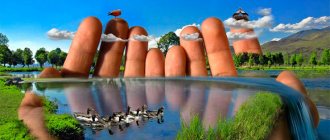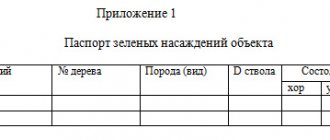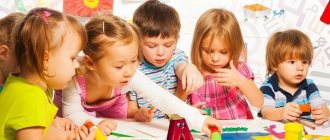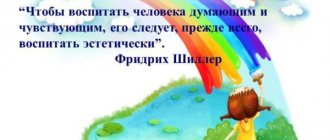Goals and objectives of environmental education
Technological progress and the rapidly developing chemical industry lead to the fact that the ozone layer is constantly thinning, drinking water supplies are decreasing, and the “lungs of the planet” - forests and groves - are disappearing.
And all this is the result of the irrational and merciless use of natural resources, which do not have time to recover. Articles on the topic
- How to raise your son to be a real man: the main truths 08/24/2021
- How to raise a successful child: 10 effective tips 07/12/2021
- Parenting techniques: how to change a child’s views and behavior 05.26.2021
- Functions of education in the formation of personality 05.26.2021
To prevent further destruction of nature, environmental education of preschoolers, schoolchildren, students and even adults who have not previously been instilled with the basics of environmental culture is necessary.
It is important to teach a child to respect nature and appreciate it as early as possible, while explaining why this is necessary. Most of this work is carried out by workers in preschool institutions, where children spend most of their time. An important fact is the involvement of parents, grandparents, brothers and sisters in this process. This way, a large number of people of different ages will be involved in the problem of environmental conservation.
The main goal of environmental education is to form in preschoolers and schoolchildren a humane attitude towards nature and its resources, to create a personality that is able to understand and realize the fact why it is important to love and protect nature in all its diversity. Perceive yourself as a part of the surrounding world, capable of creating material and spiritual values based on natural resources.
The child must understand that he can actively interact with nature in such a way as to create new benefits without destroying the beauty of the world around him.
Over many years, sufficient theoretical and practical material has been accumulated on the environmental education of preschool and school-age children.
For this purpose the following tasks are set:
- fostering a caring attitude towards the world;
- formation of environmental consciousness;
- developing interest in nature;
- directing children's active efforts to preserve natural resources.
To solve these problems, they use ecological moments, nature excursions, various experiments, educational games, living corners, and winter gardens.
Message from work experience On the topic: “Environmental education of preschool children.”
MUNICIPAL BUDGETARY PRESCHOOL EDUCATIONAL INSTITUTION
“KINDERGARTEN No. 8 “SOLNYSHKO” IN THE VILLAGE OF NOVOZAVEDNENY”
Message from work experience
On the topic: “Environmental education of preschool children.”
Completed by the teacher
highest qualification category Nasonova Oksana Alekseevna.
2021
"Environmental education of preschool children."
How many discoveries a child makes when communicating with nature! Every living creature he saw is unique. Natural materials are also diverse (sand, clay, water, snow, etc., with which children love to play. Preschoolers communicate with nature at different times of the year - both when there is fluffy white snow around and when the gardens are blooming. Not a single didactic material comparable to nature in terms of diversity and strength of developmental influence on the child. The earlier the formation of the foundations of ecological culture begins, the higher its level in the future. To teach to see and understand the beauty of native nature, to treat all living things with care, to convey certain knowledge in the field of ecology are the main tasks environmental education. In preschool age, a positive attitude towards nature, the objective world, towards oneself and other people is laid down. In my opinion, I could realize cognitive interest in the environment and emotional richness in environmental education, in the process of communication with nature: after all, ecology is space for children's activities (observation, work, play, experimental and speech activities).
I have defined goals and objectives
environmental education of children.
Target:
formation in children of elements of environmental consciousness, the ability to understand and love the world around them and nature.
Tasks:
Educational:
• formation of the foundations of ecological culture in the process of introducing preschoolers to the world through practical activities with living objects, observations, experiments, research work and work with didactic material, the formation of environmental ideas.
• children's awareness of the fact that plants and animals are living organisms; about the presence of inanimate bodies in nature, about their relationship;
• using the example of specific plants and animals, revealing the connection between structure and their functioning, the dependence of the structure of the organism on environmental conditions;
• formation of knowledge about the importance of living and inanimate nature in human life and economic activity;
• showing the positive and negative impact of man on the world around him;
Educational:
• attracting attention to the surrounding natural objects, developing the ability to see the beauty of the surrounding natural world, the diversity of its colors and shapes;
• fostering the desire and skills to preserve the natural world around us;
• fostering a sense of responsibility for the state of the environment, an emotional attitude towards natural objects.
Educational:
• development of skills to observe living objects and inanimate phenomena;
• attracting attention to the surrounding natural objects, developing the ability to see the beauty of the surrounding natural world, the diversity of its colors and shapes;
Forms and methods of work
In my work on environmental education I use various traditional and non-traditional forms, methods and techniques, taking into account the age and individual characteristics of children. To expand children's ideas about nature and deepen their knowledge, I use ICT. They, due to their clarity, colorfulness and simplicity, allow me to more effectively build the process of learning new concepts for children and for systematizing knowledge.
When working with children I use a variety of forms:
1. Practical joint activities of children and teachers.
In the morning, I involve children in joint activities, which take on different forms and organization in different age groups.
Proper pedagogical communication between the teacher and children in this event has a particularly deep meaning: preschoolers learn to see what conditions plants need, learn to determine what they lack at the moment, learn to practically perform labor actions, and master tools for the first time. My communication, as a teacher, comes down to a friendly explanation, clear demonstration, and help in every case when a child finds it difficult. When communicating, I find an opportunity to praise the child, and not just once, but several times throughout the event: at the beginning, praise instills confidence in the child’s abilities, then it is praise-support, at the end - the main praise as the result of a good deed that the child has done . Such pedagogical communication in joint activities in a corner of nature increases the environmental education of children
2. Observation.
I conduct observation cycles in a corner of nature and in a kindergarten area throughout the school year. Each cycle includes a series of observations of one object. I carry out observations of one cycle sequentially one after another with a gap of 2 - 3 days. Thus, observations were made of the growth of plantings in the “Vegetable garden in flower beds and beds.
A separate observation is a short one (5-12 minutes) I spend with a small group (4-7) of children in a corner of nature or with the whole group in the area. Depending on the content of the observations, I conduct observations at different moments: before and after breakfast, while walking, before lunch and in the evening.
We systematically observe the weather - children examine the sky every day, clarify the nature of precipitation, the presence or absence of wind, and determine the degree of heat or cold by clothing. Observing the surrounding nature, children begin to understand what is good and what is bad, to distinguish good from evil, learn to feel the beautiful and the ugly, learn to “talk” to a bird and a flower, the sun and the wind and love them. During the observations, children developed powers of observation, a strong interest in nature, and ideas about the characteristics of plants and animals.
3. Ecological trail.
The “ecological trail” plays a significant role in the environmental education of children in my work. On the territory of the preschool educational institution there is an ecological trail with a description of natural objects and speech material for them. The ecological trail performs an educational, developmental, aesthetic and health-improving function.
When creating the trail, we used as many interesting objects as possible: trees, shrubs of different species, different ages, different shapes. On the path there is an old stump, ground covered with moss, ant paths and their passages, a clearing with medicinal plants: coltsfoot, yarrow, chamomile and various insects living on it: butterflies, ladybugs, caterpillars, and a nest on a birch tree.
The flowering plants in the flower bed are very pleasing to the eye. And they are selected in such a way that during the season some flowers are replaced by others. The guys in the flowerbed took care of the flowers: loosened them, watered them. A mill was built on the ecological trail in our preschool educational institution. Children will learn about how people used to process the harvested grain.
4. Excursions and walks.
An excursion is one of the main types of classes and a special form of organizing work on environmental education, one of the very labor-intensive and complex forms of training. On excursions, I introduce children to plants, animals and, at the same time, their living conditions, and this contributes to the formation of primary ideas about the relationships in nature.
Thanks to excursions, observation skills develop and interest in nature arises. The beauty of nature that surrounds them evokes deep emotions and contributes to the development of aesthetic feelings.
I also widely use walks for environmental education of children. I introduce children to changes in nature by season (length of day, weather, changes in the life of plants and animals, human labor). On walks, I organize games with natural materials (sand, water, snow, leaves, fruits). For such games, we have equipment on the site such as a box of sand, scoops, molds, and signets. It is on a walk that children become acquainted with the properties of sand, earth, clay, snow, ice, water. Children love to play games with toys driven by the wind. Through games, children determine the strength and direction of the wind, its contrast.
5. Experimental - experimental activities.
To establish the causes of phenomena, connections and relationships between objects and phenomena, I try to use as many experiments as possible. I always build experiences on the basis of existing ideas that children received in the process of observation and work. In each experiment, the cause of the observed phenomenon is revealed, children are led to judgments and conclusions. Their knowledge about the properties and qualities of natural objects is clarified (about the properties of snow, water, plants, their changes, etc.)
Experimental activities contribute to the formation of children's cognitive interest in nature, develop observation and mental activity. As a result of working on a creative topic, I was able to not only increase my level of knowledge on this topic, but also arouse the interest of some parents in research and knowledge of the world around us. Creating conditions for children's research activities had a beneficial effect on the development of children's cognitive and research activities. Children began to ask questions more often about natural phenomena, objects, objects, and conduct simple experiments on their own; during walks, their attention was attracted by unusual finds and already familiar natural materials.
I consider it necessary to maintain the interest of children and parents in cognitive and research activities, since it promotes the development of children's curiosity, inquisitiveness of the mind and forms on their basis stable cognitive interests, which is very important when preparing a child for school.
An open lesson with children from the preparatory group on experimenting “The Secret of Sand” was interesting.
Throughout the entire lesson, the children were active, showed creativity, ingenuity, supported each other, and were interested in the types of activities offered by the teacher, which contributed to a high level of assimilation of the new material presented in the lesson.
6. Work in a corner of nature, on a plot, in a vegetable garden.
Working in a corner of nature has great educational value.
Children develop a caring, caring attitude towards nature and develop a responsible attitude towards their responsibilities. In the process of care, children gain an understanding of the diversity of the plant world, how plants grow and develop, and what conditions need to be created for them.
7. Games with environmental themes
I believe that one of the most effective and most interesting means of environmental education for children is games. I use environmental games primarily for the purpose of clarifying, consolidating, generalizing, and systematizing knowledge. While playing, children better acquire knowledge about objects and natural phenomena, learn to establish relationships between them and the environment, learn about ways of adaptation of living beings to the conditions of their habitats, about the sequential change of seasons and about changes in living and inanimate nature. Great opportunities for developing environmental feelings are found in didactic games. I use didactic games not only in children’s free activities, but also include them in classes, targeted walks, and experimental activities. These are games such as “Children on the branches”, “Tops and roots”, “Which tree is the leaf from”, “Wonderful bag”, “Guess what you ate”, “Find the same plant in the bouquet” “Who lives where”; “Flies, runs, jumps” (about the adaptation of animals to their environment); “Who has which house” (about ecosystems); “Living - nonliving”; “Birds - fish - animals” (for classification according to given characteristics); “What comes first, what comes next” (growth and development of living organisms); “Choose the right road” (about the rules of behavior in nature), etc. Games with natural materials (vegetables, fruits, flowers, stones, seeds, dry fruits) are effective. Outdoor games of a natural history nature, which are associated with imitation, arouse particular joy and interest in children the habits of animals, their way of life: “Little Frogs and Heron”, “Cat and Mice”, some games reflect the phenomena of inanimate nature: “Droplets”, “Sun and Rain”, “Cheerful Breeze”. The joy obtained in the game helps to deepen children’s interest in nature and the development of physical qualities. I organized role-playing games with natural content based on various life events - trips during my parents' vacation to the south or to the village, acquaintance with a collective farm, an excursion to a meadow, telling children about an agricultural exhibition (with demonstration of illustrations) To make it interesting for children to play games, I create the necessary situations, for example, “The chicken got lost.” Children find a small, yellow chicken (toy) that cries and says that it is lost. The children find out how he got lost. Who are his mothers, help him cross the road, feed him or offer to live with them and create the necessary conditions for him.
8 Fiction, natural history literature, illustrations, reproductions of paintings, sets of postcards, riddles.
I often use fiction in my classes. Fiction about nature has a deep impact on children's feelings. First, I use literature recommended by the kindergarten curriculum. After reading, I have a conversation with the children, ask questions, see sympathy, empathy or joy, delight in the children’s eyes.
It’s very nice when children ask questions where they show care and love for our little friends: “Will someone save him?”, “Won’t they freeze?”, “Why didn’t anyone help him?” (For example, reading L.N. Tolstov’s story “Kitten.”) It is very important to convey to children the meaning of the work and to evoke reciprocal feelings.
To help children in an entertaining way identify the features of natural phenomena, seasonal changes in nature, determine the qualities of an object, the habits of animals, I use riddles, poems, proverbs, sayings, and nursery rhymes. In nursery rhymes, all the phenomena and forces of nature come to life: the sun, rainbow, thunder, rain, wind, seasons live as animated beings.
9. Creation of an environmental project.
I developed a long-term (January - May) environmental project “The Magical World of Nature”, the objectives of which were:
— creation of an environmentally friendly environment on the territory of the preschool educational institution:
— creating conditions for effective environmental education of preschool children, promoting the development of an environmental culture and a conscious attitude towards nature;
— promoting cooperation between children and adults;
— implementation of labor education of children in the process of caring for green spaces.
The novelty of environmental projects lies in the use of information and computer technologies. The main fact that ensures the effectiveness of the educational process is the personal involvement of children and parents. By using new, exciting technologies, this inclusion can be achieved. The project allows children and parents to participate in environmental campaigns and landscaping. Working on environmental projects is a unique opportunity for children and parents to express themselves and benefit the surrounding nature of their native land.
As a result of this project:
— an environmentally friendly environment has been created on the territory of the preschool educational institution;
— the level of children’s knowledge of ecology has increased;
— the environmental competence of parents on the topic of the project has increased.
10. Visual activity.
The children reflected their impressions of communicating with nature in drawings. Exhibitions of children's works were held on the topics: “Spring has come”, “Take care of nature”, “Medicinal plants”, “Pollution of nature”, etc.
Creating conditions
To implement the tasks set for environmental education, the necessary conditions were created in the group:
— methodological, natural history and children's literature about nature was selected;
- selected paintings and sets of postcards;
— a natural corner has been created (indoor plants, weather calendar, nature calendar, observation diaries);
— a laboratory for a young researcher has been created, which contains a variety of natural materials and the necessary equipment for conducting experiments;
— tools were purchased;
— a weather site was created;
— materials for playing with sand and water have been collected.
Working with parents
I work very closely on environmental education with my family. Only by relying on the family, only through joint efforts can we solve the main task - raising an environmentally literate person. When working with parents on environmental education of children, I use both traditional and non-traditional forms. In the parent’s corner I placed a wall newspaper “Plant a tree - breathe with nature.” My parents actively helped me prepare materials for the open lesson “The Secret of Sand” and willingly took part in the cleanup work on landscaping the territory of the preschool educational institution.
I think the main goal in working with families is to achieve unity in raising a child. It is necessary that the upbringing of children in preschool educational institutions and in the family be uniform. I always stand by the fact that we have the same goal with them - to raise purposeful, kind, balanced and loving people.
To achieve this goal, I organize environmental holidays for children and parents, recreational activities in nature, exhibitions, performances, excursions, training games, tea parties, consultations. I try to hold parent-teacher meetings in a very rich and informative way, where parents attend with pleasure, as evidenced by their reviews of the meetings. I select material for information stands and communicate individually. Thus, I try to bring the family and preschool educational institution closer together
Conclusion:
The work done was reflected in the success of the children. They show positive changes in the formation of the moral qualities of the personality of preschoolers. Children began to be more attentive to the surrounding living and inanimate nature, to their comrades. They have increased their cognitive interest in natural objects and the desire to take care of them. Children learned to independently observe, care for and treat plants with care, show curiosity, pay attention to the beauty of the surrounding nature, and children’s games contain natural content. So, step by step, I instilled in the children a love of nature and a caring attitude towards it.
Features of the process for different age groups
Environmental education of schoolchildren and preschoolers is an integral part of education. At each stage, teachers use various forms of presenting material and forms of teaching that correspond to the psycho-emotional and physical development of the children.
Preschoolers
It is necessary to start environmental education from preschool age, when a small person:
- forms the basis of environmental thinking;
- accumulates his knowledge about various forms of life;
- he lays the initial elements of ecoculture.
During this period of life, children are very sensitive and receptive, their physical and mental development proceeds at a rapid pace, and basic moral qualities and character traits are formed. At the age of 3-7 years, significant changes occur in the sphere of cognition of a small person. Imaginative thinking predominates and the child establishes relationships with the world around him through direct impressions.
Preschool children have unstable attention. They quickly lose interest in one subject and switch to another, getting tired. Therefore, the “spiral” principle is used to study the natural world. Each topic is studied in small portions. Then, year after year, they return to it, deepening and expanding knowledge, using more complex techniques.
Play and love for nature
The main way of learning in preschool age is play.
Therefore, environmental education in kindergartens is carried out using games with natural elements (pebbles, shells, leaves), board games with cards (for example, putting together a picture of nature from several cards). Active games are also necessary. The game “Edible and Inedible” develops imagination well and systematizes knowledge about nature.
Theoretical knowledge is necessarily supported by practice (communication with nature, visiting a winter garden, working on a personal plot). All this contributes to the long-term preservation of children’s interest and attention to studying the world around them.
An important detail in children’s environmental education is the teacher’s response to questions that interest them. Children are inquisitive; in addition to kindergarten, they learn a lot of new things about nature from their parents, from the Internet and TV. Naturally, they have questions. And the teacher must not only convey knowledge, but also develop the logical and creative thinking of children.
The following classes are used for this:
- in the winter garden;
- living corner;
- in nature in the form of a trip, a fairy tale, a quiz.
This way, children not only consolidate the material they have covered, but also learn something new for themselves.




